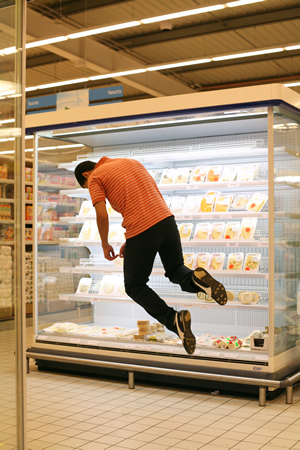Alec Soth wrote a seminal photography blog (here) then one day up and quit. And, I’m not talking “hey, I’m getting tired of this shit I think I’ll pull back a bit,” I’m talking Bermuda-triangle-sudden-radio-silence quit. I always figured the man’s got his reasons and we’ll leave it at that. But, after you’ve been on the sharp end of a blog for awhile the reasons present themselves and I started to develop theories about it. I decided to ask him “what’s up.”
Ok, so why did you quit blogging?
Well, first let me say why I started blogging in the first place. A couple years ago I had an itch to talk about creative issues. My son had just been born and I figured I wouldn’t be getting out much. More importantly, my career as a photographer was going really well but so much of my time was focused on the business side of things. While I was grateful to be making a living, I was becoming increasingly frustrated that all I talked about was prices, editions and so on. I took up the blog as a break from the business side of art. And it turned out to be a fantastic venue for that stuff. You know that feeling you have as a student where you are so hungry for knowledge and inspiration – that was the way I felt with the blog. It was great. Soon there was a sizable audience. This was flattering and cool, but it changed things. Rather than being my creative journal, the blog started feeling like a magazine. It started becoming another business. Every day I was getting dozens of emails from people showing me their work. I just couldn’t keep up. It also started affecting my real life relationships. One time I traveled to New York and was too busy to see a show by a friend of mine. The fact that I didn’t see her show and write about it on my blog, well, she hasn’t spoken to me since. It was ridiculous. As much as I loved the venue, I didn’t need the grief.
Your blog is still cited as one of the best on photography and you’ve not made a post in almost a year. Do you think any photographers will come around and usurp your title?
Of course. I’m sure it has already happened. The truth is that once I quit blogging, I also quit reading blogs. I needed to get out of the loop.
Most photographers have trouble with self promotion and so a blog probably looks like water torture. How did you deal with it?
I’m not a fan of using blogs for self-promotion. I’m as guilty as the next dork for having used my blog to talk about my new show, new book, whatever. But those were the weakest posts. You can smell self-promotion from a mile away. The good stuff would always come from genuine curiosity. If artists take up blogging just to promote their careers, their blogs won’t be worth much more than spam.
What are you up to these days?
I have two personal projects in the works. One will be ready this fall, the other in the fall of 2009. In 2010, the Walker Art Center is organizing a major traveling show & catalog. And I’m still doing plenty of editorial. I just finished a four part series for the Telegraph Magazine.
Any chance you’ll take up the blog again?
I have fantasies. I recently bought Larry Towell’s new book and was so thrilled with it. I really wish that I could go to town on it like I once did on my blog with a Tod Papageoge book. But if I go back, it will likely be on a different site. David Alan Harvey and I have been toying with the idea of functioning like columnists on the Magnum blog. Maybe I could manage being a columnist – but I’m pretty burned out on being the publisher.
